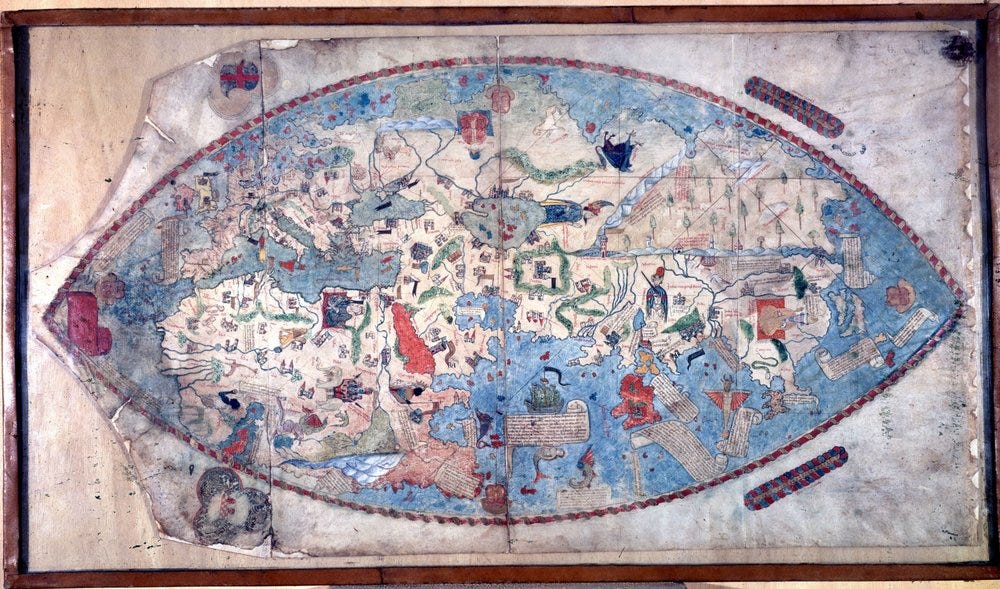The Case Of The Missing Continent
Atlantis, Lemuria, and other lost worlds of esoteric religion

“Atlantis as the origin of New World culture is a theory dating back almost to the discovery of the New World itself,” Robert Wauchope wrote in 1962.1 It became a popular idea about the Americas even before they were colonized. We can blame the Spanish and the Italians. Columbus, a Genoan, sailed west looking for the legendary island of “Antilia” on behalf of the Spanish king and queen. Then people got creative. First, Italian poet Giralamo Frocastoro in 1530, and then historian Gonzalo Fernandez de Oviedo y Valdés in 1535, suggested that the New World was populated by the descendants of the fabled Atlantis.
Over the centuries, various parties have credited ancient Egypt, Phoenicians, and the ‘lost tribes’ of Israel with founding the societies of North and South America. Yet “of all the American Indian origin theorists, advocates of the Lost Continent are by far the most devoted to their cause,” Wauchope says. He names two modern esoteric religions in particular. Emphasis added:
Lost Atlantis devotees have been, for the most part, congenital romanticists and mystics. Nowadays they are to be found among adventure readers and members of mystic organizations like the Rosicrucians and the Theosophists, but as late as the nineteenth century they counted among their number a great many old-time scholars who flocked to the local meetings and international congresses of learned societies here and abroad to expound on an advanced civilization that flourished many thousands of years ago on a giant island in the Atlantic Ocean and that colonized the ancient American continent before being destroyed by cataclysmic volcanic eruptions, earthquakes, and tidal waves, to sink beneath the sea forever.
The 19th century was a particularly febrile period for lost continents. Ernst Haeckel, a keen Darwinian taxonomist, wanted to explain the distribution of lemurs and other common species between Madagascar and Australia. In his Natural History of Creation, published in 1868, and then his Origin and Geneology of the Human Race of 1870, Haeckel proposed a hypothetical landmass, which he called Lemuria, that had slid beneath the waves of the Indian Ocean many eons ago.
At the time, his thought experiment was even more reasonable and scientific than the Atlantean controversy. Theosophy reestablished Lemuria as an explicitly spiritual project. In An Outline of the Principles of Modern Theosophy, published in 1894, Irish Theosophist Claude Falls Wright asserted that the residents of Lemuria were the “Third Race” of mankind.2 They were also “of enormous stature — from twenty-seven to even thirty feet in height” and “possessed such powers over nature as we cannot now conceive of.”
The progressive Lemurians, the ones who evolved spiritually, “are the true ancestors of present-day humanity, for it was during the period of their existence that man first received the gift of mind,” Wright explains. The fallen Lemurians on the other hand settled Atlantis, the scene of Plato’s ancient parable of collapsing civilizations.
It all sounds like Swiss UFO prophet Eduard ‘Billy’ Meier because he draws from all the same material, including lost worlds that exist both under the sea and in outer space. The lost worlds of the fantasy past are in fact the promised worlds of the heavenly future; they are the same worlds. Shangri-La, or its interstellar equivalent, is always waiting for us just beyond the horizon. ‘Atlantis in the Americas’ is a legacy of esoteric religion in the early age of science, when people already believed in extraterrestrials and even communed with them in spirit.
Previous essays in this series are available for premium subscribers:
Keep reading with a 7-day free trial
Subscribe to Osborne Ink to keep reading this post and get 7 days of free access to the full post archives.




